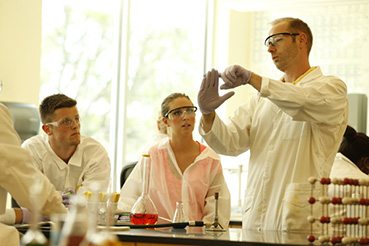A Brief History of the Art Department
Our purpose here is not to relate our entire history, but to recall our earlier days, and to pay homage to our founders.
The Art department was established in 1961, three years after the founding of Florida Presbyterian College (now Eckerd), when Dean John M. Bevan hired Robert O. Hodgell, a nationally known printmaker, painter and sculptor, as the college’s first studio faculty member. In 1963 Hodgell was joined by James G. Crane (cartoonist, painter and collage artist), and in 1965, by Margaret Rigg (graphic designer, assemblage artist and calligrapher). Crane and Hodgell had both been contributing artists to motive, a progressive Methodist monthly magazine, of which Rigg was the Art Editor. motive understood the power of imagery, and in the 60’s motive’s message was a vigorous blend of faith and humanism.
This energy and spirit naturally carried over into the founding of the FPC/Eckerd Visual Arts Department, and Hodgell, Crane and Rigg worked together to inspire a generation of young artists, activists and teachers.
As studio programs were still relatively new to American higher education, there were few blueprints to follow. Of the art faculty only Jim Crane had ever taught in college, so he became department chair. It was Jim who invented our Visual Problem Solving and Studio Critique courses. And in a stroke of pedagogical genius it was determined that our seniors should have a personal exhibition as a capstone experience, equivalent to a thesis, and that students should have personal studio space in which to work independently.
Physically, the Visual Arts program was much like a hermit crab in its early days. The campus gallery throughout the 60’s was simply an open stretch of floor space and a temporary wall and display panels in the Wm Luther Cobb Library. In fact the art offices, the printmaking studio, and the drawing & painting studio were all located in the southwest end of the library. Dormitories in Alpha Complex served as student studios. Welding was done in the downstairs lobby of Gandhi House, and the darkroom was in the upstairs bath. Critique classes were held in or outside the complex lounge.
One of our early alums, John Eckert (’69), earned his MFA at Cranbrook in 1971, and returned to become Assistant Professor of Art. John taught a variety of courses, but ultimately concentrated on developing our program in ceramics.
In 1971 the studios were moved from Alpha Complex to new pre-fabricated huts that had been erected on the grounds between Bininger Theatre and Roberts Music Center.
In 1972 FPC became Eckerd College, and construction began on the Ransom Arts Center, named for its generous donors, Christiana and Woodbury Ransom, pictured inspecting the dedication plaque.
The gallery meanwhile had moved from the library to the Student Union in Lindsey Hall in 1970. In 1973 it was named the Frances Cady Elliott Gallery, after a major donor to the college, and in 1978 it was moved to the Ransom Arts Center.
Founding Faculty
A Legacy: Robert Hodgell
In tribute to Robert Hodgell, Jim Crane said “I asked Bob a question: ‘What keeps you going when no one is buying your work, writing about it or maybe even seeing what you are doing? What keeps you going through neglect, when no one cares if you make art or not?’ Bob looked at me as if that haunting question had never occurred to him. He answered simply ‘It is what I do.’ It was what he did, and who he was. It was his vocation in the oldest religious sense. It was his calling.”
Students of those early days may recall fondly his “lectures” in general education when, with a seated model, he would do a full painting on stage within an hour, not saying a word. Most of those in the audience had never witnessed such an intense moment of the creative process in action.
Hodgell retired from teaching in 1978 in order to pursue his art full-time. Virtually every day of his life was spent making works of art, and it is truly humbling to consider his prodigious output in painting, sculpture and printmaking. Robert Hodgell passed away in March of 2000, but his art continues to delight and inspire us daily.
James G. Crane
Of Jim Crane, Nancy Corson Carter once wrote, “Claiming one’s own life vision has been a continuing theme of Jim Crane’s teaching…He considers himself a teacher of artists and not of art, his students as children who grow up and affirm the visions they seeded together.”
Indeed, while Jim won numerous awards and honors with his works in painting and collage, and published several books of cartoons besides, it could be said that his greatest creative work was in teaching itself.
Jim Crane dedicated thirty years of service to the college as Visual Arts Discipline Coordinator, Patriarch and Resident Visionary. He steadfastly guided us through times of both light and of darkness, and with remarkable wisdom and wonderfully insightful humor.
Jim Crane passed away in 2015, but his legacy lives on. More than anyone else Jim shaped the Visual Arts program at FPC/Eckerd: its structure, its curriculum, and its essential teaching philosophy.
Margaret R. Rigg
Margaret Rigg once wrote: “In my calligraphy I want to join with others, past present and future. And if someone along the way sees one of my calligraphies and feels somehow that it is addressed directly to them even if we never meet face-to-face, we, together, establish community. It is not only an emotional contact, but a spiritual and physical one. In this way my calligraphies are like letters. They contain ideas, images, feelings that I want to say to another human being, to God, to myself.” It can truly be said of Peg that she has made an art of communication.
Peg is the author of three books, and has to her credit more than sixty one-woman shows in the U.S., Europe, Asia, South America, and the Caribbean. Her tireless efforts as an artist and teacher to promote peace, justice and an awareness of our human potential have made a tremendous and indelible impact upon all who have come in contact with her.
Peg retired from teaching in 1998 after thirty-three years of dedicated service to the college. For having invented the concept of Autumn Term for first-year students, and for her years of exemplary mentoring, in 2008 Eckerd College awarded her with the John Satterfield Outstanding Mentor Award. Margaret Rigg passed away in July, 2011, but the light of her teaching continues to serve as an inspiration for us all.
John K. Eckert
Although John Eckert was not technically a founding art faculty member, he was with us nearly from the beginning, having arrived as a freshman in 1965. Soon after graduating in 1969 he earned his MFA at the Cranbrook Academy, and then returned to FPC/Eckerd to become Assistant Professor of Art in 1971. His talents were diverse, and in the course of his teaching he developed our programs in photography, woodshop, and above all, in ceramics. John remained with us for nearly seventeen years, until his most untimely death in 1987.
John’s involvement with the art community had extended beyond the campus, and he was especially engaged in developing the strength and integrity of the programs offered at the Arts Center of St. Petersburg.
Each year in his memory the John Eckert Award is given to an outstanding regional voice in ceramics at the Arts Center of St. Petersburg. And fittingly, since 2001 this coveted award has been won by four Eckerd Visual Arts ceramics alumni: Ian Meares ’00, Rachel Fia Fuselier ’00, Anne Holth ’03, and Adrian Zuniga ’16.
Banner: “In Review”, linocut, c.1968 by Robert Hodgell
Gallery hours:
Mon.–Fri., 10 a.m.-5 p.m.

Peace, Justice, Mercy, and Remembrance
Works from the Permanent Collection
January 6 – February 7, 2025

Prints, Drawings, and Pinhole Photographs
A Retrospective of Works by Arthur Skinner ’72
January 20 – February 21, 2025

The Other Side of the Fence
A Ceramic Installation by Tony Baker
January 27 – March 9, 2025

Materiality in Art and Medicine
Works by Margaret Brommelsiek ’80
February 10 – March 14, 2025
Winter Term Photography and Video
Works from Study Abroad
February 24 – March 28, 2025
Fly, Amanita and Other Beauties
Works by Brandi Palmer ’97
March 17 – 28, 2025
Senior Thesis Exhibitions
Visual and Interdisciplinary Arts Majors
Art Therapy Concentrations
March 23 – May 16, 2025
Senior Thesis
Interdisciplinary Arts: Troy Lessly
During the week of April 27, 2025 (tba)
The 17th Annual IA Show
Interdisciplinary Arts Junior Portfolio Exhibition
March 30 – April 4, 2025
The 54th Annual Sophomore Show
Visual Arts Portfolio Exhibition
Part I: April 6 – 11, 2025
Part II: April 13 – 18, 2025
The Eckerd Review
Works Selected for Publication
May 4 – 16, 2025






